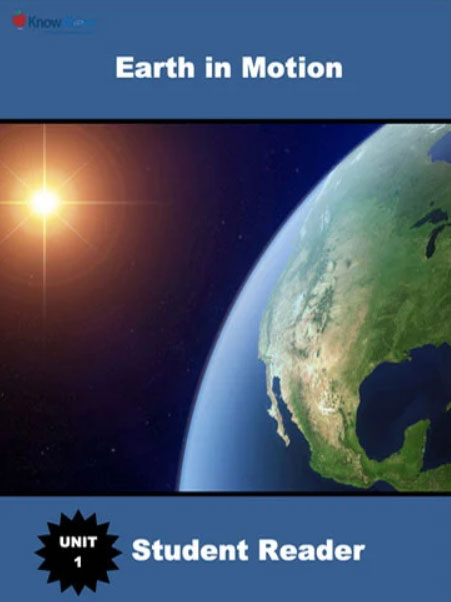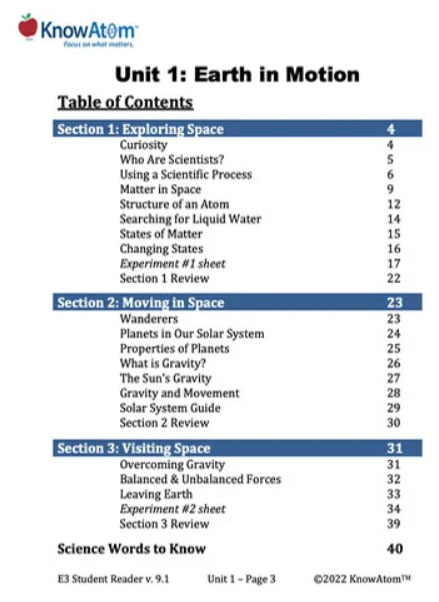Once students have modeled an atom, they investigate how the motion of atoms changes when heat is added to or removed from a substance. In this lesson, students carry out an experiment to observe how heat affects the movement of liquid molecules.
In this unit, students use the scientific process to analyze Earth’s place in the solar system. They begin by modeling how matter is made up of tiny particles called atoms, and changes state when heat is added or removed. This page provides an overview of lesson 1B in which students explore the science phenomena of how heat affects matter.
The science background gives educators more in-depth information about the phenomena being explored in this unit.
All of the matter in the universe can be found in one of several states of matter, depending on the amount of available heat. The three most common states of matter are solid, liquid, and gas. There is a fourth state, called plasma, which most stars are found in because of their tremendous heat.
Scientifically, temperature is a measure of how fast molecules are moving. When it is cold, molecules have little energy and move around slowly. When it is hot, molecules have a lot of energy and move very quickly. As particles of matter move faster, they expand from a solid state to a liquid state, and then to a gas state.
Matter in a solid state holds its own shape until something changes it. The particles are packed closely together and vibrate in place. When solid matter is heated past its melting point, the atoms or molecules move so quickly that it expands and changes into a liquid.
Matter in a liquid state takes the shape of its container, but it has no shape of its own. The particles are close together, but they have enough energy to slide past one another. When a liquid is heated past its boiling point, the liquid expands and changes into a gas.
Matter in a gas state has no shape and spreads out into space. The particles have so much energy that they move far apart and bounce around randomly.
Earth is unique in our solar system because it is the only planet where water exists naturally as a solid, a liquid, and a gas. This occurs because of Earth’s temperature range. Water molecules make up the ice found in glaciers and the liquid water in oceans. Water molecules are also the water vapor gas that mixes with air. This fact is particularly intriguing to scientists looking for signs of life beyond Earth because liquid water is necessary for almost every known living thing. Without liquid water, there would be no life on Earth.
Once students have modeled an atom, they investigate how the motion of atoms changes when heat is added to or removed from a substance. In this lesson, students carry out an experiment to observe how heat affects the movement of liquid molecules.

Prepared hands-on materials, full year grade-specific curriculum, and personalized live professional development designed to support mastery of current state science standards.
Misconception: Only Earth has gravity.
Fact: All matter has gravity. All objects near Earth’s surface are pulled on by Earth’s gravity because Earth is the most massive object near us.
Misconception: Earth doesn't move in the solar system.
Fact: The sun’s gravity keeps Earth and the other planets in orbit.
Misconception: If an object is at rest, no forces are acting on it.
Fact: Forces are constantly acting on objects both at rest and in motion.
Atom : the smallest piece of matter that has the properties of an element; a combination of three subatomic particles: protons, neutrons, and electrons
Cause and Effect : a relationship between events or things, where one is the result of the other
Force : a push or pull that acts on an object, changing its speed, direction, or shape
Gravity : a force of attraction between all matter
Mass : a measure of the amount of matter that makes up an object; a property of matter
Matter : everything that has mass and takes up space
Pattern : something that happens in a regular and repeated way
Scale :the size, extent, or importance (magnitude) of something relative to something else
Science : all knowledge gained from experiments
States of Matter
Earth is unique. Unlike on Mars, water molecules are found almost everywhere on Earth, in all three states. Water molecules make up the ice found in glaciers. They make up the liquid water in the oceans. Water molecules also make up the water vapor gas that mixes with air.
Ice is water’s solid state. A solid has its own shape until something changes it by force. Solids such as ice hold their shape because the atoms that make them up are packed tightly together. They do not have enough energy to move past one another.
Liquid water has no shape of its own. It takes the shape of its container. This is because the atoms in a liquid are close together but can slide past one another. This is why liquids flow.
Water vapor is water’s gas state. A gas takes the shape of whatever it is in. It will spread out to fill all of the space it is in, no matter how big the space is. This is because the atoms in gasses are far apart and move with a lot of energy.
Changing States
Water isn’t the only molecule that can be a solid, liquid, and gas. Every atom and molecule can be turned into a solid, liquid, or gas when the right amount of heat is added or taken away. Matter changes state because of the amount of heat present. Heat causes the motion of atoms to change.
When you add enough heat to a solid, it will become a liquid. When you add enough heat to a liquid, it will become a gas. If you take away enough heat from a gas, it will become a liquid. If you take away enough heat from a liquid, it will become a solid.



In this lesson, students conduct an experiment to answer the question: “How does heat affect the movement of liquid water molecules?” Students compare the height of liquid water in a straw before and after it is heated. Then, they use the data they gathered in the heat and matter experiment as evidence to support the claim that the behavior of atoms determines the properties of matter.
KnowAtom incorporates formative and summative assessments designed to make students thinking visible for deeper student-centered learning.
.png?width=321&height=390&name=Screenshot%20(8).png)
Standards citation: NGSS Lead States. 2013. Next Generation Science Standards: For States, By States. Washington, DC: The National Academies Press. Neither WestEd nor the lead states and partners that developed the Next Generation Science Standards were involved in the production of this product, and do not endorse it.